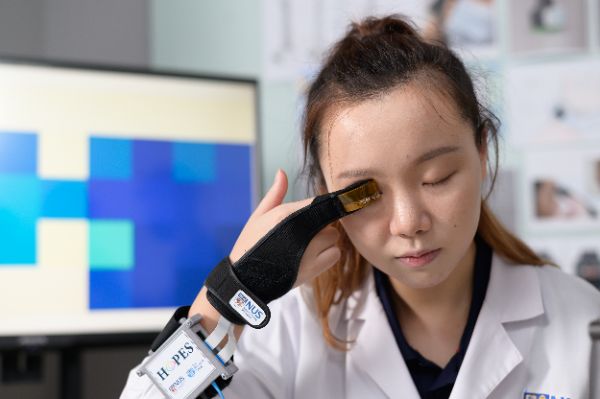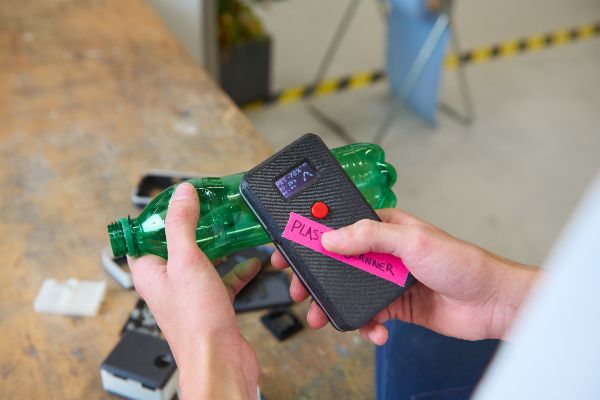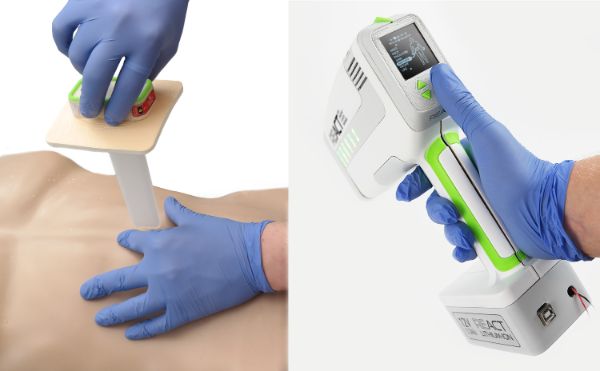World-improving Inventions Named Global Winners Of The James Dyson Award 2021
International winner: HOPES, a device for pain-free, at-home eye pressure testing, opening access to glaucoma testing, by students at the National University of Singapore.

Sustainability winner: Plastic Scanner, a low-cost, handheld device to identify plastic for recycling, by Jerry de Vos from TU Delft.

Medical winner: REACT, a device to stem bleeding to help save the lives of stabbing victims, by Joseph Bentley from Loughborough university.

NEW ZEALAND. 17 NOVEMBER 2021. In 2021, the James Dyson Award received a record number of entries worldwide and Sir James Dyson chose three global winners, each receiving $57,000 NZD in prize money to support the next stages of their inventions. This is the first time there has been three winners. The James Dyson Foundation has now given nearly $1.9 million NZD in prize money to over 250 promising inventions from young engineers and scientists in 28 countries around the world.
Commenting on this year’s competition, Sir James Dyson said:
“I enjoy seeing the enthusiasm with which young people tackle the world’s problems using good design, engineering and science. So promising were this year’s entries that we’ve awarded a third prize, focused on medical invention. Commercialising an idea is very hard – I hope that the awareness that the award drives, as well as the financial support it provides, will give these ideas a springboard to success.”
International winner – HOPES, designed by Kelu Yu, Si Li and David Lee
The problem
It is estimated that 2% of New Zealanders over 40 have glaucoma. It is projected that the number of people aged 65 and over with glaucoma will double by 2046. Globally, glaucoma is the second leading cause of blindness. It is largely symptom-free, it’s also known as the “silent thief of sight”. There is no cure but, if diagnosed and treated early, blindness can be prevented.
This year’s International winner of the James Dyson Award was inspired by one of the inventors’, Kelu, father’s diagnosis of glaucoma. After witnessing his discomfort and multiple hospital visits, she realised there is a global need for a less invasive and more accessible method for Intraocular Pressure (IOP) monitoring.
The solution
Today, regular IOP monitoring is a critical tool in helping clinicians determine long-term treatment plans and goals. This is achieved through the Goldmann Applanation Tonometry – regarded as the gold standard for the measurement of IOP. There is a demand for safe, accurate, low-cost, at-home IOP measurement devices to better improve the patient experience.
HOPES (which stands for Home eye Pressure E-skin Sensor) is a wearable biomedical device for pain-free, low cost, at-home IOP testing. Powered by patent pending sensor technology and artificial intelligence, HOPES is a convenient device for users to frequently self-monitor IOP.
After creating a profile in the App, the user wears the HOPES glove with the sensor placed at the fingertip, pressing this against the centre of the eyelid. The fingertip employs a unique sensor architecture that captures dynamic pressure information of the user's eye with sub-millisecond precision. The captured signals are processed by machine learning algorithms to continuously and accurately compute users’ IOP.
Data is transmitted via Bluetooth to paired devices or uploaded to the Cloud to be accessed remotely by clinicians. The App prompts users with easy-to-read measurement history and direct links to healthcare systems, allowing them to seek medical help to minimise future symptoms.
“I’ve experienced first-hand how invasive and unpleasant the tests for glaucoma can be, but it is a vital test. This group of young people have tackled a problem that doesn’t affect them directly, but which affects members of their family. Their work has the potential to make glaucoma testing much more widely available and I wish them every success as they navigate the challenging process of further development and medical approvals,” says Sir James Dyson, Founder and Chief Engineer at Dyson.
On winning the James Dyson Award International prize, the team say: “We were thrilled to hear from Sir James Dyson that we are this year’s International winners of the James Dyson Award. For us this all started with Kelu and her attempt to create a solution for her father after the problem they faced as a family. With this win, we hope in the future people can measure their eye pressure in a pain-free, at-home environment. We want to improve people’s quality of life and aspire to one day apply our research group’s sensor technology across different health monitoring applications, such as robotics and biomedical devices.”
Sustainability winner – Plastic Scanner, invented by Jerry de Vos
The problem
According to the Packaging Council of NZ, New Zealanders consume about 735,000 tonnes of packaging every year and recycle only about 58% of it. Plastic has a bad reputation because it is often not thought to be recyclable and so ends up in landfill, or worse on the beach or in our oceans. However, with the right technologies plastics can be widely recycled successfully at end of life and transformed into new products, which themselves are long-lasting and durable.
The challenge is identifying the plastic so that it can be recycled in the correct way, rather than sent to landfill. The technology exists but is expensive and rare. With greater availability of plastic identification much more plastic can be recycled and therefore used more effectively.
The solution
The Plastic Scanner is a handheld device that when held against plastic will tell the user what materials it’s made from, using infrared light to detect the plastic components. The Plastic Scanner uses discrete infrared light to detect types of plastic – a new and low-cost approach to traditional infrared spectroscopy. The Scanner is also fully open-source hardware, so anyone can assemble the breakout board and embed the electronics into a handheld device. Open source welcomes feedback and improvements from experts, so the project will continuously improve as more people recycle plastic around the world.
Jerry is a member of Precious Plastic, an organisation that aims to reduce plastic waste. Through his work for the organisation he has witnessed the negative impact of plastic pollution first-hand and the bottlenecks caused when plastic is not identified and sorted in the recycling process. Around the world, much of this process is done by hand which takes time and is prone to error. Jerry has seen successful technology used in large factories in the Netherlands where infrared reflections assist with the sorting. This is a vital step for ensuring it is recycled properly. Jerry’s mission has been to make this technology available for everyone around the world so they can recycle better.
Jerry learnt that much plastic entering our oceans comes from low and middle-income countries. It is his mission to support recycling initiatives in these nations with the way he designed the low-cost and ease of use of the Plastic Scanner. During development, Jerry interviewed recyclers from India, Indonesia, Kenya and Curacao to ensure his model was suitable for end users.
“It may be fashionable to demonise plastic but it is a durable and versatile material which has an important role to play. The challenge, of course, is ensuring it is reused and recycled effectively to avoid it going to landfill. Understanding how to recycle plastics correctly is complicated but Jerry has developed a very effective technology that could put this knowledge into everyone’s hands. Jerry is focussing his efforts on supporting developing countries. When I rang Jerry to deliver the news, he was travelling to Algeria to help local communities deploy recycling initiatives, his is inspiring work and I wish him every success with this potentially significant technology” says James Dyson, Founder and Chief Engineer at Dyson.
After speaking to James Dyson, Jerry said: “When James Dyson personally told me that I had won the Sustainability prize, I was stunned and then started to realise the impact of this win and the possibilities the Award generates. The goal of the Plastic Scanner is to build a simple, open-source device that can identify the most common types of plastic. I am so motivated after winning the James Dyson Award and it will help accelerate the development process on both the electronics, as well as the software side of the invention. By improving its quality and making it intuitive to replicate, I hope to enable anyone to identify and sort plastic properly, overcoming one of the most complex barriers to recycle plastic anywhere around the world.”
Medical winner – REACT, invented by Joseph Bentley
The problem
In 2019, the number of Aucklanders going to emergency departments and being hospitalise with stab wounds is increasing. In 2012, it was reported that the average response time in rural areas was 12 minutes while it was 25 minutes in remote areas. However, a person can bleed to death in less than five minutes.
The solution
The REACT device (which stands for Rapid Emergency Actuating Tamponade) aims to reduce catastrophic blood loss from a knife wound. The current advice for treating stab wounds is to never remove the knife object from the wound if it is still in place. This is because the object is applying internal pressure to the wound site whilst also filling the cavity and preventing internal bleeding. Joseph’s concept is based on the same principle, the implantable medical-grade silicone balloon tamponade would be inserted into the wound tract by a first responder. The actuator device is connected to the tamponade valve, and the user selects the wound location on the device interface. Squeezing the trigger on the actuator starts the automated inflation sequence, and the tamponade is inflated to a defined pressure based on the wound location to try and stem the bleeding.
During the early research and development phases, Joseph discovered that current wound management techniques like wound packing are sometimes used by paramedics to prevent bleeding from stab wounds. This process involves tightly packing a wound with gauze, which will help to apply pressure internally to the site. According to Joseph, the process can be slow, technical, and extremely painful to the victim, but has in many cases proven to be successful in quickly stopping bleeding from knife wounds.
Despite this, the technique may not be suitable for wounds in cavities like the abdomen, which is the most common area for knife wounds to appear following a knife attack. During his prototyping, Joseph found that the simple application and automated inflation procedure of the REACT system could be a more effective method for first responders compared to traditional methods. He claims his prototype Tamponade could potentially be in place and stopping haemorrhage in under a minute, which Joseph estimates could save hundreds of lives a year.
“This type of problem solving invention shows the significant impact engineers can have on serious, global issues, and is why I created the James Dyson Award. Developing a medical device is very challenging and there will be no end of hurdles, but I would urge Joseph not to be put off since the opportunity to save lives is so great. I hope that through winning the Award this invention gets the support it requires as it has the potential to make an impactful change,” says James Dyson, Founder and Chief Engineer at Dyson.
“I am beyond words in describing my gratitude in receiving this global prize dedicated to a medical innovation. Knife crime is horrific and a global challenge that is claiming the lives of thousands every year. The REACT system has the potential to be a life-saving tool in the fight against knife-crime, but the development of medical devices is a long and challenging process. The recognition and funding provided by the James Dyson Award has given me the determination and confidence to develop the REACT system and getting it into the hands of first responders as soon as possible,” says Joseph after learning the good news from James Dyson.
For further information on the New Zealand national finalists, please read on Dyson Newsroom here.
....................................
The James Dyson Award forms part of a wider commitment by Sir James Dyson, to demonstrate the power of engineers to change the world. The Dyson Institute of Engineering and Technology, the James Dyson Foundation and James Dyson Award encourage aspiring engineers to apply their knowledge and discover new ways to improve lives through technology. Since the competition first opened in 2005, James and the James Dyson Foundation have donated over £135m to boundary-breaking concepts in education and other charitable causes. The Award has supported nearly 300 inventions with prize money.
ABOUT THE INVENTORS OF HOPES
This year’s International winners are Kelu Yu, Si Li (both from China) and David Lee (from Singapore), all past and present students from the National University of Singapore. The three young inventors are passionate about engineering’s role in transforming everyday life. And their inventive minds started from a young age; Kelu enjoyed Physics and Maths at school encouraged by her family’s engineering background, David was always dissecting household objects to understand how they work – even building his own house-hold sound system, and Lisi too was inspired by his parents’ engineering careers. The story of HOPES began in late 2019, when Kelu’s father was diagnosed with glaucoma. He suffered from constant eye pain and headaches, having to visit the doctor for eye pressure tests lasting whole days. The uncomfortable treatment and frequent hospital visits deeply impacted Kelu and motivated her to better understand the disease. The team have since spent the past 18 months designing, ideating, and prototyping HOPES to fill a gap they identified in glaucoma management – the need for a safe, non-invasive, low-cost, at-home eye pressure sensor. Following their Award win, the team are focused on improving the machine learning model, optimising the App, and working with local hospitals in Singapore to pilot HOPES in context.
ABOUT THE INVENTOR OF PLASTIC SCANNER
Jerry de Vos is a 28-year-old Industrial and Product Design graduate from Tu Delft, the Netherlands. He started the development of the Plastic Scanner in 2017 after seeing the devastating impacts of plastic pollution when volunteering at Precious Plastic. The Plastic Scanner is a low-cost, handheld device that tells you the type of plastic you’re scanning to better the recycling process, focused on supporting developing countries. Jerry has always had a hunger to improve how things work and invented the Plastic Scanner using his background in electronics and product design. His inventive mind blossomed at a young age, fascinated by improving his toy cars with magnets and sketching perspective drawings at six years old. Jerry travels to developing countries where he trials the Scanner with local people to help improve their recycling processes, most recently working with refugees in Algeria.
ABOUT THE INVENTOR OF REACT
Joseph Bentley is a 22-year-old Product Design and Technology graduate from Loughborough University, UK. He has always had a keen interest in engineering but felt that his dyslexia held him back when it came to performance in traditional exams. However, through his passion for product design Joseph discovered that he could pursue a career in engineering. Design has given him the opportunity to learn a process for solving real world problems, and after working on the government’s ventilator response during his placement year, Joseph found the confidence to address medical challenges from a design perspective. After having two friends seriously injured because of knife crime, he used his final year design project as an opportunity to develop a new technology for stopping bleeding in a knife wound, REACT. Joseph has now founded the company ACT Medical and is continuing the development of the REACT device, focussing on designing and manufacturing working prototypes for clinical testing.


 Ngā Pae o te Māramatanga: Māori Concerns About Misuse Of Facial Recognition Technology Highlighted In Science
Ngā Pae o te Māramatanga: Māori Concerns About Misuse Of Facial Recognition Technology Highlighted In Science Retail NZ: Retailers Call For Flexibility On Easter Trading Hours
Retail NZ: Retailers Call For Flexibility On Easter Trading Hours WorkSafe NZ: Worker’s Six-Metre Fall Prompts Industry Call-Out
WorkSafe NZ: Worker’s Six-Metre Fall Prompts Industry Call-Out PSGR: Has MBIE Short-Circuited Good Process In Recent Government Reforms?
PSGR: Has MBIE Short-Circuited Good Process In Recent Government Reforms? The Reserve Bank of New Zealand: RBNZ’s Five Year Funding Agreement Published
The Reserve Bank of New Zealand: RBNZ’s Five Year Funding Agreement Published Lodg: Veteran Founders Disrupting Sole-Trader Accounting in NZ
Lodg: Veteran Founders Disrupting Sole-Trader Accounting in NZ



